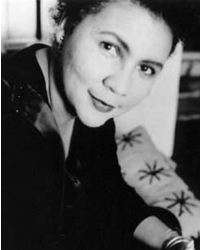U Cincinnati Aims to Give First-Generation Students a Home Away from Home

First-generation college graduate bell hooks (b. 1952) has gone on to become one of the post influential feminist scholars of our time.
***
The ’80s and ’90s saw colleges across the country designating dorm space — a floor, a wing or, in some cases, an entire building — as race-/ethnicity-based theme housing. Some students welcomed these options as opportunities for building connections with others with similar heritage. Others saw race-specific housing as modern-day segregation. Nevertheless, race-based theme housing is now a feature on many college campuses.
One of the main arguments that colleges give in support of race-specific housing is that it decreased the isolation that many students of color feel on majority white campuses. In the 21st century we are hearing much the same concern from administrators about students from economically marginalized backgrounds, especially those who are the first in their family to attend college. According to the Pell Foundation, only 11% of entering first-generation students will ultimately graduate from college, and isolation and the feeling of being an outsider are two key factors in this high attrition rate.
Yesteday’s New York Times included an article (by Dana Jennings) about one very unique effort to apply the ethnic/race-based theme house approach to the question of economical and social class. The University of Cincinnati has created the Gen-1 Theme House for first generation incoming students. According to Program Coordinator Judith Mause, the Gen-1 Theme house is designed to be “an anchor as the students learn to navigate the university and to be their own advocates.”
Gen-1 house has the potential to feel like a home away from home. For first year students in their late teens, just leaving the supervision of their parents and grandparents, Gen-1 house certainly has some of the rules of home. Students who choose this housing option must sign a contract agreeing to a strict code of behavior. There must be “no alcohol or overnight visitors, midnight curfew on weeknights and 3 a.m. on weekends.”
If Gen-1 house can increase the graduation rate for first generation college entrants, than I hope (and expect) to see other institutions adopt the same approach. Still, Gen-1 house does have the same drawbacks identity-based theme housing (from race to gender to religion). When I think back on my own college experience, I cherish the memories of making strong bonds with other Black students. But I also learned immense amounts from — and built close and lasting friendships with — students whose life experiences were far different from mine, in terms of class and race, religion and geographic region, and too many other characteristics to name here.
But then again, maybe it’s hard to take pleasure in the diversity of experiences and backgrounds on your campus when the things that so many of the other students share — a seemingly inherent sense of entitlement to all of the opportunities that the university has to offer and the complete absence of doubt about whether or not they are “college material” — just reinforces your own feelings of uncertainty and isolation.
To read more about U Cincinnati’s Gen-1 Theme House, follow any of the LINKS in this post.
Posted by Ajuan Mance
Posted in Current Events, Higher Education